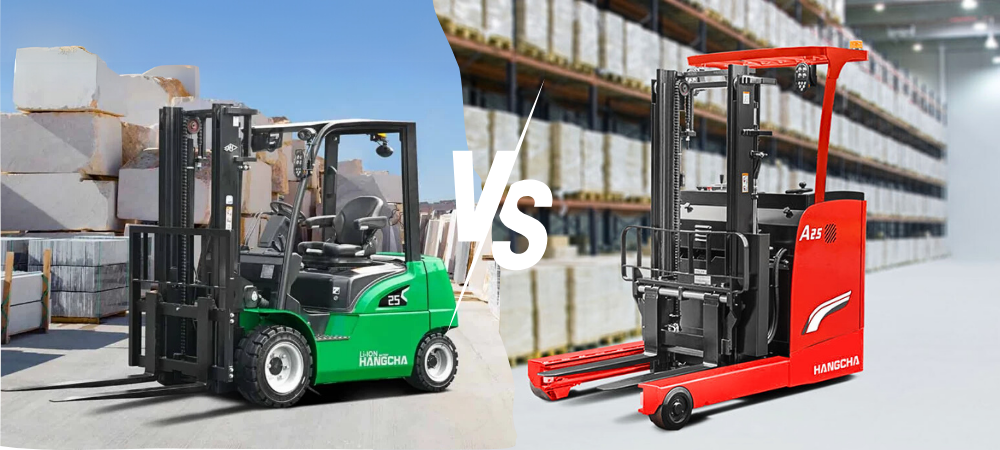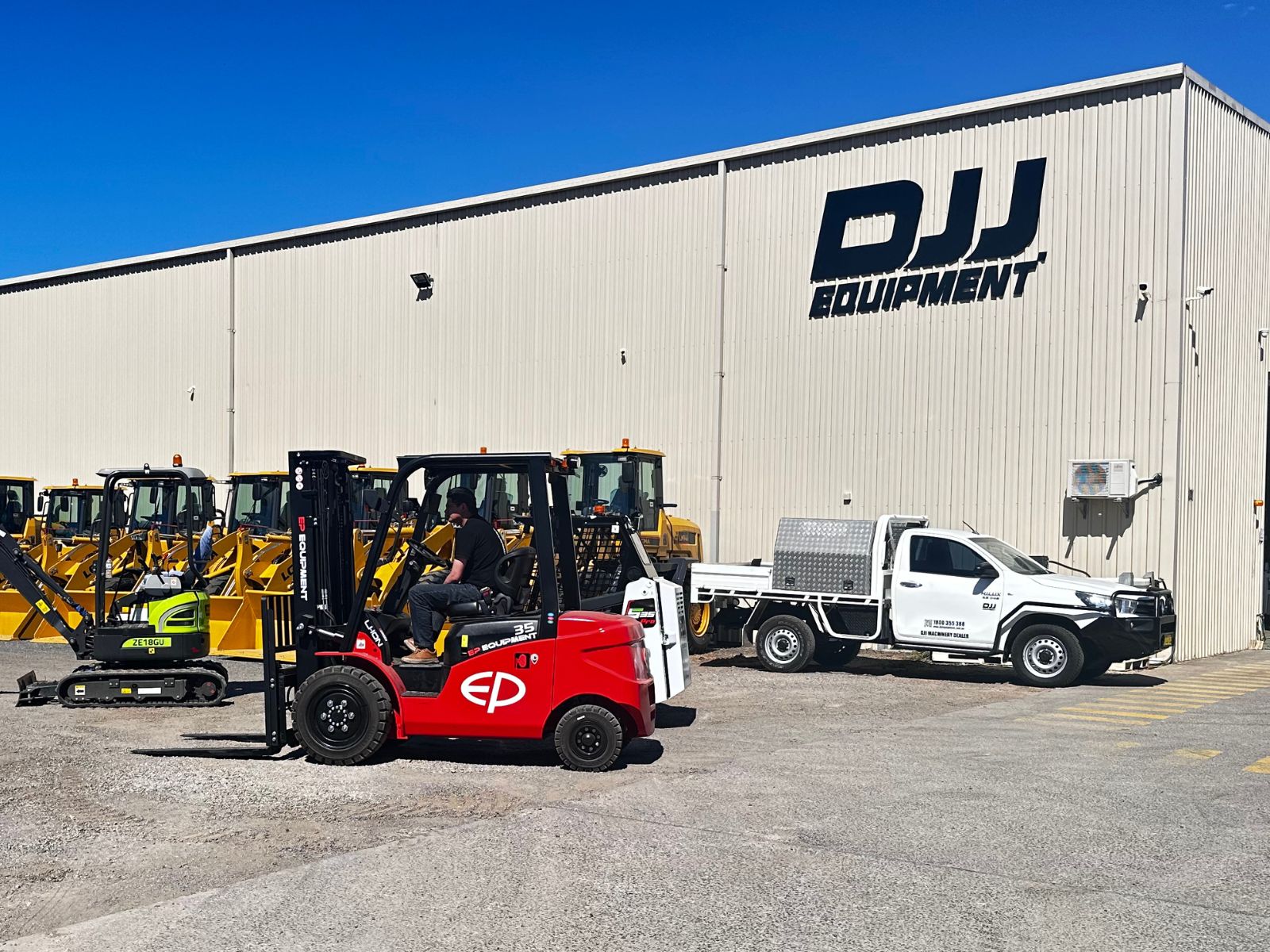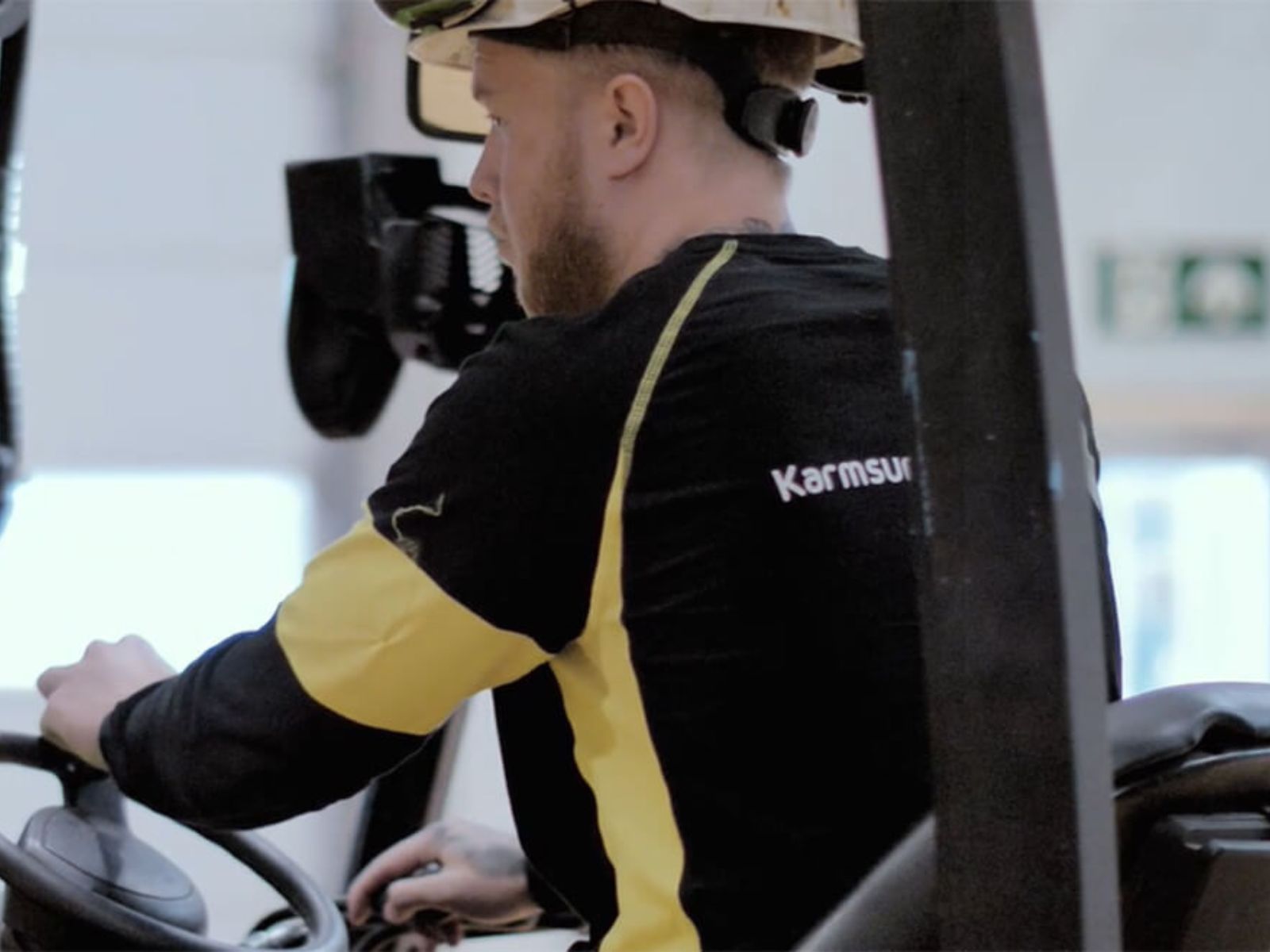When people talk about forklifts, they usually mean counterbalance forklifts—powerful, all-purpose machines found across warehouses and job sites. But today, reach trucks are becoming the go-to for modern warehouses with narrow aisles, high shelves, and limited space.
If you’re new to reach trucks or not sure how they differ from traditional forklifts, this article is for you. We’ll break it down in simple terms. Click here to explore DJJ Equipment’s full range of forklifts and expert support.

Reach Trucks vs Counterbalance Forklifts Explained: Structural Differences
The main difference comes down to how the machines balance their load:
- Counterbalance forklifts: carry heavy loads out front. To stay upright, they have a counterweight at the back. When lifting, the entire forklift must move forward.
- Reach trucks: on the other hand, use support legs that extend past the wheels and a reaching mechanism that allows the forks to move forward independently. The battery also adds to the stability. Because of this design, reach trucks can lift pallets without moving the entire truck, which is perfect for tight warehouse spaces.
Common Reach Truck Types:
- Single-Reach Trucks – Most common, designed for one pallet depth.
- Double-Reach Trucks – Access two pallet depths, increasing storage density.
- Moving Mast Reach Trucks – Instead of extending forks, the entire mast moves.
- Multidirectional Reach Trucks – Can move sideways, great for long or bulky items.
Where Reach Trucks vs Counterbalance Forklifts Fit In: Industry Classification
To help standardise forklift types, manufacturers use the ANSI/ITSDF B56 classification system. Here’s how reach and counterbalance forklifts fit:
- Reach Trucks: Class II – Electric Narrow Aisle Trucks
- Counterbalance Forklifts:
- Class I – Electric counterbalance
- Class IV – Internal combustion, solid tyre
- Class V – Internal combustion, pneumatic tyre
- Class VII – Rough terrain forklifts
Reach Trucks vs Counterbalance Forklifts: Key Specs

Load Capacity
Counterbalance forklifts typically have a much higher load capacity than reach trucks. In fact, standard counterbalance models on the market can safely lift anywhere from 1.8 tonnes up to 48 tonnes, depending on the size and configuration.
Reach truck forklifts, on the other hand, are generally limited to a maximum of 2.5 tonnes. This is because their design prioritises reach and lift height over heavy-duty lifting.
Lift Height
This is where reach trucks really shine. Designed specifically for high-level stacking, most modern reach trucks can lift loads up to 15 metres—ideal for tall racking systems commonly found in warehouses and 3PL storage facilities.
By contrast, most standard counterbalance forklifts have a maximum lift height of around 6 metres, making them more suitable for ground-level or low-rack operations.
Turning Radius
A typical counterbalance forklift needs around 3.7 metres of aisle width to turn effectively.
In contrast, reach truck forklifts are much more compact and agile. For example, models from leading brands like Hangcha can operate in aisle widths as narrow as 2.38 metres, making them perfect fornarrow aisle warehouse applications.
Power Source
For counterbalance forklifts under 2.5 tonnes, electric models are common. Once you move into the mid- to high-tonnage range, you’ll find a broad range of fuel options: diesel, LPG, petrol, and electric. This flexibility makes counterbalance forklifts more adaptable across indoor and outdoor environments.
In contrast, Indoor high-reach vehicles are almost exclusively electric—powered by either lead-acid or lithium-ion batteries. This makes them ideal for indoor, clean-energy environments but limits their use in rough or outdoor settings.
Working Surface & Terrain Requirements
Both machines are designed to work best on flat, stable surfaces, but the demands on ground quality are different.
Counterbalance forklifts, particularly those fitted with pneumatic or solid tyres, can handle rougher conditions, including some outdoor environments and uneven terrain. Larger tyres and higher ground clearance also allow for use on slopes and rugged surfaces—especially in all-terrain models designed for construction or yard use.
High-lift warehouse trucks, on the other hand, rely on smaller polyurethane or cushion tyres and require smooth, level indoor flooring—ideally sealed concrete. Even asphalt is generally not recommended, and slopes or wet environments can affect battery life and traction.
Reach Trucks vs Counterbalance Forklifts: Maintenance and Servicing
Reach-type forklifts have more complex systems that often require specialist maintenance, making urban service access a plus. However, indoor use means less wear and tear. In contrast, counterbalance models—especially diesel ones—are mechanically simpler and often easier to service on-site.
DJJ Equipment provides full maintenance and repair support to keep your fleet running smoothly.
Reach Trucks vs Counterbalance Forklifts: Attachments & Compatibility
- Reach trucks have limited space for attachments. The most common are side shifters and fork positioners, especially in cold storage applications.
- Counterbalance forklifts offer more space for attachments, allowing for side shifters, fork positioners, rotators (used with bins or drum clamps), push-pull attachments, and even front extenders that replicate reach functionality.
Operator Training
In Australia, both types fall under the LF licence. But even experienced counterbalance drivers should retrain before using a reach truck.
Reach trucks handle differently—slimmer masts, different lowering speeds, and unique safety procedures. If you already have forklift driving experience, learning to operate a reach truck may take less than a week.
Looking Ahead
As cities grow and warehouse space shrinks, reach trucks are becoming essential. Higher racking, faster picking, and smarter layouts all favour narrow-aisle machines. If you’re investing in a forklift for your warehouse, choosing the right type can help unlock your full storage potential.
In summary, reach trucks offer key advantages in lift height, compact size, and forward-extending forks—making them ideal for maximizing vertical space and pallet density. They’re especially useful in narrow warehouses across Sydney or Melbourne, helping reduce floor space requirements and long-term storage costs—where industrial rents can exceed $200/m² in some areas.
Need a reach truck? Browse our forlifts or contact us—we’d be happy to help you find the perfect fit.
— FAQ —
A reach truck is a type of forklift designed for narrow aisles and high racking. It uses extending forks and stabilizing legs to lift pallets without moving the whole truck—ideal for indoor warehouses.
Reach trucks offer higher lift heights (up to 15m), compact size for tight spaces, and efficient vertical storage. They are electric-powered and perfect for indoor use.
“Reach truck” is a type of narrow aisle forklift (Class II). Not all narrow aisle forklifts are reach trucks, but all reach trucks are designed for narrow aisles with forward-reaching forks.
Class 4 and 5 forklifts are internal combustion counterbalance forklifts:
Class 4: Solid tyres for indoor use.
Class 5: Pneumatic tyres for outdoor use.
Yes, most reach trucks are stand-up forklifts. Operators typically stand sideways in the cab to allow easy entry and better visibility in narrow aisles.






.webp)